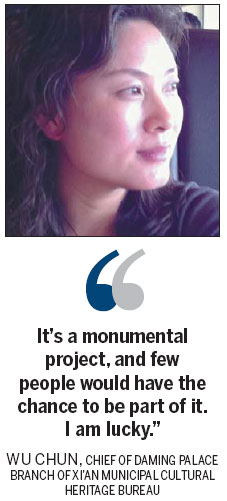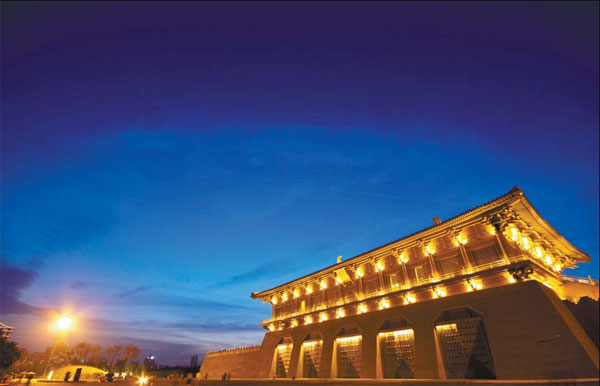A model of restoration
Updated: 2013-05-17 07:50
By Zhang Lei and Lu Hongyan (China Daily)
|
||||||||
|
The Daming Palace National Heritage Park has not only restored the history of Xi'an, but also brought tourists and money to the city, the capital of 13 dynasties. Provided to China Daily |
How they turned around 1,100 years of history
In January, the Chinese film director Feng Xiaogang had the nation in tears with his disaster epic Remembering 1942 about the exodus of refugees in Henan province fleeing severe famine.
The film depicts the story of around 10,000 people who fled west along a railway track, eventually settling on wasteland north of the old Xi'an railway station in Shaanxi province.
Weary, hungry and 400 kilometers from home, little did they know they had arrived at a spot that was once the political hub of 13 dynasties, known as Daming Palace.
The palace was already neglected and for decades to come this continued, with the surrounding district becoming one of the poorest in the city despite erratic efforts at preservation and a restoration project in the 1990s.
But in 2007, its fortunes changed, when the government launched a protective construction project entrusted to the city's Qujiang New District,which had experience in restoration work.
According to Wu Chun, chief of Daming Palace Branch of Xi'an Municipal Cultural Heritage Bureau, "The Qujiang team had gained a lot of experience with Tang Paradise (a theme park in Xi'an), Tang City Wall and Qujiang relic parks. So they had a good idea of how to make the most of relics to stimulate the local economy. The way they work leans heavily toward cultural protection."
As a way of building infrastructure for the palace's surrounding areas, the government requested that the Qujiang team incorporate 16 square kilometres of neighboring communities into the Daming Palace renovation project and also set up a team to maintain the palace's cultural relics.
Qujiang in turn set up an affiliated investment company to raise funds and organize the construction project.
The end result of the project was the opening of Daming Palace National Heritage Park in October 2010, and along with it the relocation of 10,000 people to adjacent communities and the reinvention of a once poor and crime-infested area into the city's central park.
The history of Daming Palace is long, impressive and volatile. Four times bigger than the Forbidden City in Beijing and 12 times the size of Versailles in Paris, it was destroyed at the end of the Tang Dynasty in the 10th century and later underwent sporadic attempts at restoration.

The royal residence of the Tang emperors for more than 220 years, Daming Palace was built in 635 during the reign of Emperor Taizong. Construction stopped after Taizong's father died and was finally completed in 683 to become the imperial court.The palace has 11 gates and measures 7.6 sq km. Its main thoroughfare, Danfengmen Street, is 176 meters wide and more than 40 pavilions have been unearthed within its grounds, most built around the Taiye Pool to the north of the palace. They include Hanyuan Hall, Linde Hall, Sanqing Hall, Qingsi Hall, Xuanzheng Hall and Zichen Hall.
Emperors held ceremonies and met officials in Hanyuan Hall, which has a foundation of over 15 meters high. The hall, which is nearly 80 meters long from east to west and more than 41 meters wide from south to north, is 11 rooms wide and four rooms deep. It is the central hall of Daming Palace, with each gate about 5 meters wide. To the west of Daming Palace is Linde Hall, where emperors met foreign envoys. The hall covers 12,300 sq meters.
Efforts to restore and preserve the palace and cultural relics from within it have been erratic over the years.
According to Wu, "In the 1980s, the government set up a relic depository here at Daming Palace with a staff of just 20, but when the economy improved in that period, the whole area became a forest of small factories."
Over the years, damage to the ruins steadily mounted. "There was only one line of water supply to the palace," Wu says. "Each day you could see villagers lining up for water. They complained about the lack of basic infrastructure and for them protecting Daming Palace was just an inconvenience and a hassle."
Funds to preserve the palace became scarce. Money to restore and maintain the palace that began to flow in 1961 when it was placed on China's national heritage list, dried up to just 2 million yuan a year. That was "not even enough to pay to protect the two halls," Wu says.
The most recent renovation project and also most comprehensive has seen a huge change in government funding with 12 billion yuan spent, 9 billion of which was reportedly paid as relocation compensation. According to the Daming Palace Branch of Xi'an Municipal Cultural Heritage Bureau, the investment led to a 1 point rise in the city's GDP in 2010.
"Our bureau made sure that during construction the emphasis was on preserving relics and that no ruins would be compromised by any of the work or by anything that was built," says Wu.
Daming Palace National Heritage Park is different to other relic parks and theme parks in Xi'an because of its archaeological functions, she adds."Archaeological works are being carried out, and we set up zones that separate tourists from them. And members of the public who are interested in archaeology are selected every year to witness the unearthing work," she says.
"Beside each ancient site, we set up two different display boards, one for archaeologists and one for tourists."
The palace also has miniatures on a 15-to-1 scale placed in front of each ruin to help visitors get a clear picture of what the palace looked like before. "We also set up an experience center and a museum that gives visitors an all round knowledge of the palace," Wu says.
"For example, for Japanese tourists, there is a video presentation of how Abe Nakamaro arrived in Chang'an (the ancient name of Xi'an) and how he, a Japanese, became a government officer in the Tang Dynasty."
The palace also hosts re-enactments of Tang officials going to court at Danfeng Gate, Daming Palace's south gate. This has created a boom in Han Chinese costume groups, especially during traditional festivals. Many newlyweds also wear Han-style clothes and profess their love for each other at the gate."It is because of these rituals and activities that our palace is alive again," Wu says.
Last year 60 commercial building projects were under way around the palace, and it is Wu's job to ensure that they are in line with that of the palace.In the first half of last year the park had 4.43 million tourist visits; before 2008, it received just 100 visits a year.
"I have been involved in the Daming Palace project from the start," Wu says. "It's a monumental project, and few people would have the chance to be part of it. I am lucky.
"It is the soul of the city, and has to be incorporated into the city planning."
Contact the writers at zhanglei@chinadaily.com.cn and luhongyan@chinadaily.com.cn
(China Daily 05/17/2013 page15)

 Michelle lays roses at site along Berlin Wall
Michelle lays roses at site along Berlin Wall
 Historic space lecture in Tiangong-1 commences
Historic space lecture in Tiangong-1 commences
 'Sopranos' Star James Gandolfini dead at 51
'Sopranos' Star James Gandolfini dead at 51
 UN: Number of refugees hits 18-year high
UN: Number of refugees hits 18-year high
 Slide: Jet exercises from aircraft carrier
Slide: Jet exercises from aircraft carrier
 Talks establish fishery hotline
Talks establish fishery hotline
 Foreign buyers eye Chinese drones
Foreign buyers eye Chinese drones
 UN chief hails China's peacekeepers
UN chief hails China's peacekeepers
Most Viewed
Editor's Picks

|

|

|

|

|

|
Today's Top News
Shenzhou X astronaut gives lecture today
US told to reassess duties on Chinese paper
Chinese seek greater share of satellite market
Russia rejects Obama's nuke cut proposal
US immigration bill sees Senate breakthrough
Brazilian cities revoke fare hikes
Moody's warns on China's local govt debt
Air quality in major cities drops in May
US Weekly

|

|








